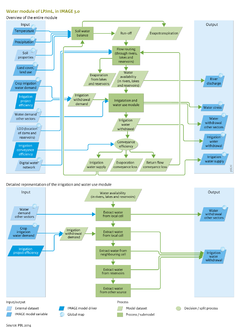Water/Data uncertainties limitations
Parts of Water/Data uncertainties limitations
| Component is implemented in: |
|
| Related IMAGE components |
| Projects/Applications |
| Key publications |
| References |
Data, uncertainty and limitations
Data
The Hydrology module of LPJmL uses external data on the river flow direction (Rost et al., 2008).
Uncertainty in water availability
Three water-extraction sources are distinguished in LPJmL: rivers and natural lakes, man-made reservoirs, and groundwater. Simulations of water availability from all sources suffer from uncertainty.
Inter-comparison of global hydrology models shows that LPJmL simulations of monthly discharges are in agreement with estimates of other global hydrology models (Haddeland et al., 2011). However, a validation of simulated discharges with observations for 300 locations worldwide (Biemans et al., 2009) showed that LPJmL overestimates discharge from some basins in the tropics, but underestimates discharges from several arctic basins. The underestimations in the Arctic may be explained to a large extent by known errors in precipitation input data. The overestimations in the (sub)tropics are caused by processes not described in LPJmL, such as evaporation losses from wetlands, tropical rivers and floodplains.
Because uncertainties in precipitation input data propagate through to the calculation of river discharge, multiple climate change scenarios need to be used in assessment of future water availability, as in Gerten et al. (2013).
LPJmL’s reservoir operation scheme simulates management of 7000 of the world’s largest reservoirs, as well as withdrawal and distribution of irrigation water from those reservoirs. Biemans et al. (2011) calculated that reservoirs contribute annually around 500 km3 of irrigation water. As there are no other studies that quantify the contribution of reservoirs to irrigation, the uncertainty in this estimation is difficult to determine. Globally, groundwater contributes around one third of the water supply used for irrigation. Groundwater availability is not explicitly included in the model and there are no global data on the quantity of usable groundwater storage. Siebert (2010) provides such an assessment without differentiating between renewable and fossil groundwater. As it is unknown how long various groundwater reservoirs could continue to be exploited, uncertainty about future availability of groundwater resources results in uncertainty in the assessment of future water stress.
Uncertainty in water demand
Several studies have shown that the key factor in increased water stress is increasing water demand rather than changing climate (Vörösmarty et al., 2000; Biemans, 2012). Thus, scenario assumptions on expansion of irrigated areas and increases in water-use efficiency in all sectors influence assessment of future water stressed areas. Although there is consensus that water demand will increase as population grows, the extent of this increase largely depends on scenario assumptions on the size of irrigation areas and on efficiency improvements.
Uncertainty about future water availability, water demand and water stress propagates to other model components, for example to crop yield simulations and future cropland allocations. More extensive assessment of uncertainties with respect to the quantification of agricultural water availability and demand can be found in Biemans (2012).
